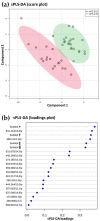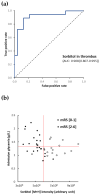Metabolome of Cerebral Thrombi Reveals an Association between High Glycemia at Stroke Onset and Good Clinical Outcome
- PMID: 33255770
- PMCID: PMC7760729
- DOI: 10.3390/metabo10120483
Metabolome of Cerebral Thrombi Reveals an Association between High Glycemia at Stroke Onset and Good Clinical Outcome
Abstract
Despite the fact that glucose is the main fuel of the brain, hyperglycemia at hospital admission is generally associated with a poor functional outcome in stroke patients. This paradox may be explained by the lack of information about the blood glucose level at stroke onset. Here, we analyzed the metabolome of blood cells entrapped in cerebral thrombi to gain insight into their metabolism at stroke onset. Fourty-one consecutive stroke patients completely recanalized by mechanical thrombectomy within 6 h were included. The metabolome of retrieved thrombi was analyzed by liquid chromatography tandem with mass spectrometry. Discriminant Analysis (sparse Partial Least Squares Discriminant Analysis (sPLS-DA)) was performed to identify classification models and significant associated features of favorable clinical outcome at 3 months (modified Rankin Scale (mRS) < 2). sPLS-DA of the metabolomes of cerebral thrombi discriminated between stroke patients with a favorable or poor clinical outcome (Area Under the Curve (AUC) = 0.992 (0.931-1)). In addition, our results revealed that high sorbitol and glucose levels in the thrombi positively correlated with favorable clinical outcomes. Sorbitol, a short-term glycemic index reflecting a high blood glucose level at stroke onset, was found to be an independent predictor of good outcome (AUC = 0.908 (0.807-0.995)). This study demonstrates that a high blood glucose level at stroke onset is beneficial to the clinical outcome of the patient.
Keywords: glucose; metabolomics; sorbitol; stroke; thrombectomy; thrombosis.
Conflict of interest statement
The authors declare no conflict of interest.
Figures





Similar articles
-
Impact of Hyperglycemia According to the Collateral Status on Outcomes in Mechanical Thrombectomy.Stroke. 2018 Nov;49(11):2706-2714. doi: 10.1161/STROKEAHA.118.022167. Stroke. 2018. PMID: 30355207
-
Fasting Hyperglycemia and Long-term Outcome in Patients with Acute Ischemic Stroke Treated with Mechanical Thrombectomy.J Stroke Cerebrovasc Dis. 2020 May;29(5):104774. doi: 10.1016/j.jstrokecerebrovasdis.2020.104774. Epub 2020 Mar 19. J Stroke Cerebrovasc Dis. 2020. PMID: 32201103
-
Mechanical Thrombectomy in Acute Stroke Due to Carotid Occlusion: A Series of 153 Consecutive Patients.Cerebrovasc Dis. 2018;46(3-4):132-141. doi: 10.1159/000492866. Epub 2018 Sep 13. Cerebrovasc Dis. 2018. PMID: 30212823
-
Admission hyperglycemia and outcomes in large vessel occlusion strokes treated with mechanical thrombectomy.J Neurointerv Surg. 2018 Feb;10(2):112-117. doi: 10.1136/neurintsurg-2017-012993. Epub 2017 Mar 13. J Neurointerv Surg. 2018. PMID: 28289148
-
Glycemia management in acute ischemic stroke: current concepts and novel therapeutic targets.Postgrad Med. 2019 Sep;131(7):423-437. doi: 10.1080/00325481.2019.1651206. Epub 2019 Aug 12. Postgrad Med. 2019. PMID: 31382796
Cited by
-
Metabolite signature in acute ischemic stroke thrombi: a systematic review.J Thromb Thrombolysis. 2023 Nov;56(4):594-602. doi: 10.1007/s11239-023-02869-9. Epub 2023 Aug 14. J Thromb Thrombolysis. 2023. PMID: 37580625 Free PMC article.
-
Metabolomic Signatures of Scarff-Bloom-Richardson (SBR) Grade in Non-Metastatic Breast Cancer.Cancers (Basel). 2023 Mar 23;15(7):1941. doi: 10.3390/cancers15071941. Cancers (Basel). 2023. PMID: 37046602 Free PMC article.
-
Advancing Stroke Research on Cerebral Thrombi with Omic Technologies.Int J Mol Sci. 2023 Feb 8;24(4):3419. doi: 10.3390/ijms24043419. Int J Mol Sci. 2023. PMID: 36834829 Free PMC article. Review.
-
Unexplored Roles of Erythrocytes in Atherothrombotic Stroke.Neurol Int. 2023 Jan 23;15(1):124-139. doi: 10.3390/neurolint15010011. Neurol Int. 2023. PMID: 36810466 Free PMC article. Review.
-
Clot Composition Analysis as a Diagnostic Tool to Gain Insight into Ischemic Stroke Etiology: A Systematic Review.J Stroke. 2021 Sep;23(3):327-342. doi: 10.5853/jos.2021.02306. Epub 2021 Sep 30. J Stroke. 2021. PMID: 34649378 Free PMC article. Review.
References
-
- Goyal M., Menon B.K., Van Zwam W.H., Dippel D.W.J., Mitchell P.J., Demchuk A.M., Dávalos A., Majoie C.B.L.M., Van Der Lugt A., De Miquel M.A., et al. Endovascular thrombectomy after large-vessel ischaemic stroke: A meta-analysis of individual patient data from five randomised trials. Lancet. 2016;387:1723–1731. doi: 10.1016/S0140-6736(16)00163-X. - DOI - PubMed
-
- Powers W.J., Rabinstein A.A., Ackerson T., Adeoye O.M., Bambakidis N.C., Becker K., Biller J., Brown M., Demaerschalk B.M., Hoh B., et al. Guidelines for the early management of patients with acute ischemic stroke: 2019 update to the 2018 guidelines for the early management of acute ischemic stroke: A guideline for healthcare professionals from the american heart association/american stroke association. Stroke. 2019;50:e344–e418. - PubMed
-
- Wang H., Zhang M., Hao Y., Zi W., Yang N., Zhou Z., Geng Y., Wang Z., Li H., Xu G., et al. Early prediction of poor outcome despite successful recanalization after endovascular treatment for anterior large vessel occlusion stroke. World Neurosurg. 2018;115:e312–e321. doi: 10.1016/j.wneu.2018.04.042. - DOI - PubMed
LinkOut - more resources
Full Text Sources

